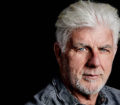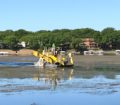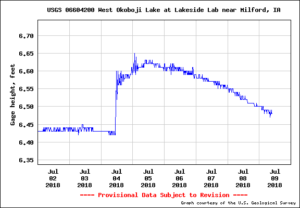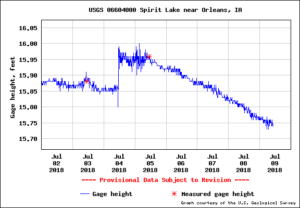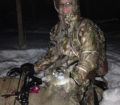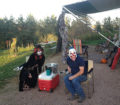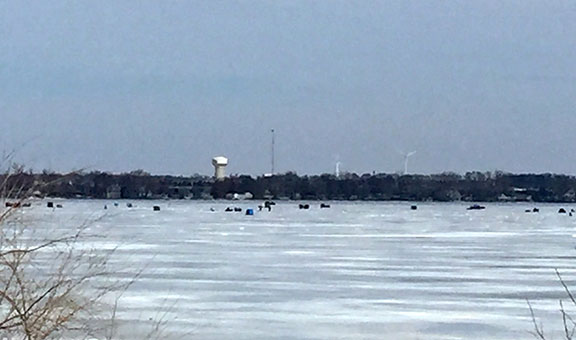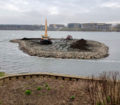By Steve Weisman
What crazy weather we have had over the past couple of weeks in northwest Iowa with intense flooding in so many areas. It seems as if we would get past one system and another would come. Rivers were overflowing, some roads became unnavigable…it seemed everything was flooded.
Here on the Iowa Great Lakes we went from concern for the lakes, to a 600-foot no-wake zone and then on July 3 the Dickinson County Emergency Management Commission met in emergency session to discuss the rising waters and after taking input from residents and state and local officials, the commission voted to implement a lake-wide emergency 5 mph speed limit on all lakes in Dickinson County immediately that afternoon.
I truly felt that this decision was the best possible decision considering the rising waters and the potential for more heavy rainfall by the end of the day on July 4. Bill Maas, Commission chair, had given me a call to let me know the commission’s decision so I could help spread the word. I told Bill that I concurred with their decision, and I felt they were doing what was best for our area lakes. I was concerned about all of the boaters on the lake for the 4th of July, but the word spread quickly. I felt that our lakes were being given a fighting chance, and with a long-range forecast showing only a few scattered thunderstorms, we might have turned the corner (of course, long range forecasts do change).
At the end of June, I sat at the Okoboji Protective Association (OPA) board meeting and had the chance to sit in on a presentation by DNR Fisheries Biologist Mike Hawkins. It was of great interest because he went through the flooding that had been occurring throughout northwest Iowa and then focused specifically on the Iowa Great Lakes. I also found that I could go to the Dickinson County Emergency Management website and click on the weather tab. There you can look at the current lake and river levels and see the rise and fall for the most recent 8-day period.
Comparing 1993 to 2018
The following is data collected by Michael Ehret, Dickinson County Emergency Management Coordinator. Although we don’t know what the next few weeks will bring, let’s first look at the flood year of 1993. Back then, going into the spring, Big Spirit was incredibly low and some old timers were saying it could take years for the lakes to get back to normal. Then the rains began and continued, 34.48 inches to be exact through the 5th of July, and they kept coming. Suddenly, Big Spirit was full and the entire Iowa Great Lakes chain was full, but it didn’t end there. The overflow could not handle the continued influx of rainfall and runoff, and soon Big Spirit began to back up and water rose to 36 inches over crest. Even with the use of sandbags, many homes and cabins on Big Spirit became surrounded by water. The rest of the chain felt the impact as the water made its way out the Lower Gar outlet with flooding of low bank areas. From June 30 through early September, there was a no-wake ordinance on the entire chain. It took a long time to get somewhere going 5 mph. It was definitely a disaster.
So, here we are in 2018. Our rainfall is close to that of 1993 with 32.42 inches, but there are differences. In 2018, the entire system was full and water was running over the spillway in early spring. Yet, here we are in early July, and while we are over crest and an entire no-wake has been implemented, the damage has not been nearly as bad as 1993. Of course, we do have several more weeks where things could get worse, but for now, we are holding our own.
According to Hawkins, infrastructure put in place over the past 25 years has made a huge difference. First off, shallow lake renovation on water bodies in the Iowa Great Lakes watershed has helped slow runoff, handle sediment and minimize the nutrient load that before had gone right into the main lakes.
Improvements have been made in the watershed with wetlands restored in key areas to help filter and slow down the water entering the system, along with prairie strips that do the same. One such prairie strip is along the east side of Big Spirit and owned by Eric Hoien. At the OPA meeting, Mary Skopec, Executive Director of the Iowa Lakeside Laboratory, addressed this crucial piece of land. After one of the huge rains, the nutrient load leaving the cropland was extremely high as it came to the prairie strip. However, after being filtered and slowed by the prairie, there was a total lack of nutrient load entering Big Spirit. Before this practice was installed, the sediment and nutrient load was huge.
Land purchases such as the Reeds Run Wildlife Area, a 43-acre parcel, the Okoboji Vu project and Center Lake Restoration are all examples of addressing watershed issues. At the same time, low impact development has increased, helping manage the storm water that comes off the streets, sidewalks and driveways.
Because of the 1993 flood, construction of a second raceway at the spillway has helped move water more quickly and efficiently out of Big Spirit, while the same holds true at the Lower Gar outlet, where water can leave the system more efficiently.
More work to do
With the good news, came this challenge: there is more work to do. There have been bank erosion situations on both East and West Okoboji. The problem is too much water getting to the edges of banks. You can even go along the shoreline and see where these potential erosion low spots are. The land can only take so much before it begins to slide, along with trees and shrubs to the lakeshore below. We really need to look at what we can do to address these situations back away from the bank-across the road or in the nearby field. Prairie strips, grass waterways, wetlands, cover crops and no till are all options that can be addressed. There are payment incentives for landowners to help.
The local Farm Service Agency, the Natural Resources Conservation Service and the Dickinson Clean Water Alliance are all here to answer questions and help with planning a wise conservation plan. As a matter of fact, a new statewide CRP continuous signup 51 just became available for Iowa’s landowners.
We need to look at conservation practices in towns, where we can put rain gardens, pervious pavers and other ways we can stop all the rainfall going right into the storm sewers and into the lakes. It will, however, take sacrifices from all of us. I encourage all of us to join the lake protective association of our choice. A group can always make more “noise” than an individual.
We really do have another chance to do this right! By all of us working together, we can definitely make a significant difference especially for the future. We have certainly made strides over the past 25 years, but we have much more to do!
(graphs courtesy Dickinson Co. Emergency Management) These two graphs show the recent water levels for Big Spirit and West/East Okoboji for the most recent 8-day period ending on July 9.

